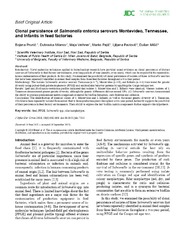| dc.creator | Prunić, Bojana | |
| dc.creator | Milanov, Dubravka | |
| dc.creator | Velhner, Maja | |
| dc.creator | Pajić, Marko | |
| dc.creator | Pavlović, Ljiljana | |
| dc.creator | Mišić, Dušan | |
| dc.date.accessioned | 2020-06-03T14:09:21Z | |
| dc.date.available | 2020-06-03T14:09:21Z | |
| dc.date.issued | 2016 | |
| dc.identifier.issn | 1972-2680 | |
| dc.identifier.uri | https://vet-erinar.vet.bg.ac.rs/handle/123456789/1399 | |
| dc.description.abstract | Introduction: Novel molecular techniques applied in biotechnology research have provided sound evidence on clonal persistence of distinct serovars of Salmonella in feed factory environments, over long periods of time (months, even years), which can be responsible for repeated in-house contamination of final products. In this study, we examined the possibility of clonal persistence of isolates of three Salmonella serovars that have been repeatedly identified in animal feed samples from three feed factories throughout a two-year period. Methodology: The isolates Salmonella enterica serovars Tennessee (n = 7), Montevideo (n = 8), and Infantis (n = 4) were tested for genetic diversity using pulsed-field gel electrophoresis (PFGE) and multicellular behavior patterns by applying the Congo red agar test. Results: SpeI and XbaI macro-restriction profiles indicated that isolates S. Montevideo and S. Infantis were identical, whereas isolates of S. Tennessee demonstrated greater genetic diversity, although the genetic differences did not exceed 10%. All Salmonella serovars demonstrated the ability to produce predominant matrix compounds essential for biofilm formation, curli fimbriae and cellulose. Conclusions: The identification of identical clones of S. Montevideo and S. Infantis, as well as the minor genetic diversity of S. Tennessee, which have been repeatedly isolated from animal feed in three production plants throughout a two-year period, indirectly suggests the possibility of their persistence in feed factory environments. Their ability to express the key biofilm matrix components further supports this hypothesis. | en |
| dc.publisher | J Infection Developing Countries, Tramaniglio | |
| dc.relation | info:eu-repo/grantAgreement/MESTD/Technological Development (TD or TR)/31071/RS// | |
| dc.rights | openAccess | |
| dc.rights.uri | https://creativecommons.org/licenses/by/4.0/ | |
| dc.source | Journal of Infection in Developing Countries | |
| dc.subject | feed | en |
| dc.subject | PFGE | en |
| dc.subject | Salmonella spp. | en |
| dc.subject | rdar morphotypes | en |
| dc.title | Clonal persistence of Salmonella enterica serovars Montevideo, Tennessee, and Infantis in feed factories | en |
| dc.type | article | |
| dc.rights.license | BY | |
| dcterms.abstract | Павловић, Љиљана; Велхнер, Маја; Прунић, Бојана; Пајић, Марко; Миланов, Дубравка; Мишић, Душан; | |
| dc.citation.volume | 10 | |
| dc.citation.issue | 6 | |
| dc.citation.spage | 662 | |
| dc.citation.epage | 666 | |
| dc.citation.other | 10(6): 662-666 | |
| dc.citation.rank | M23 | |
| dc.identifier.wos | 000379266500016 | |
| dc.identifier.doi | 10.3855/jidc.7313 | |
| dc.identifier.pmid | 27367016 | |
| dc.identifier.scopus | 2-s2.0-84976564354 | |
| dc.identifier.fulltext | https://vet-erinar.vet.bg.ac.rs/bitstream/id/365/1398.pdf | |
| dc.type.version | publishedVersion | |

